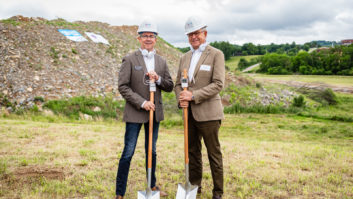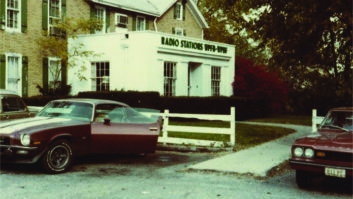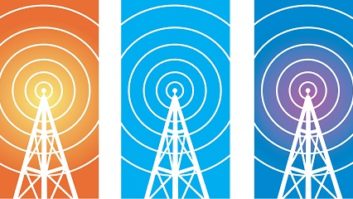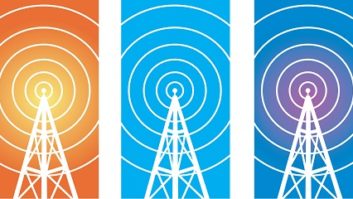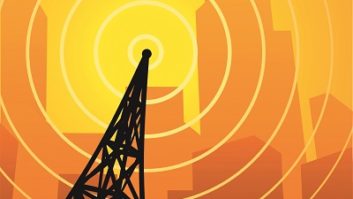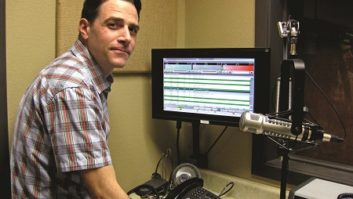Sacred Heart Radio
Sep 1, 2004 12:00 PM, by Allen J. Singer
Ever since the earliest years of radio broadcasting, even when radio was still in its infancy, religious messages have been available somewhere on the dial. Whether from a dynamic preacher shouting from the pulpit or a more sedate call-in talk show, radio has enabled the spiritual word to be available to listeners all over the world. In the United States alone, listeners have a choice of more than 1,500 stations.
For those who follow the Catholic faith, however, the choices are somewhat limited. About 60 Catholic radio stations dot the airwaves from Cincinnati to Houston. Some of these stations operate out of back rooms of the owners’ homes, rebroadcasting EWTN satellite radio. EWTN provides 24-hour Catholic programming for its affiliates: daily Masses, teaching programs, prayers and a variety of call-in talk shows.

The Holy Spirit Center in Norwood, OH, a community that is part of the Cincinnati metro area, houses the studios of WNOP.
Several of the affiliates are run by people who have never worked in broadcasting before. These devoted Catholics believe they were �called in faith� to deliver Catholic teachings over the radio, and their stations are supported by donations and underwriting. It is unusual for a station owner to have broadcasting experience, and even more unusual for the affiliate to offer local programming in addition to the satellite rebroadcast.
Sacred Heart Radio, WNOP 740 AM, in Cincinnati breaks that mold. This station is operated by Bill Levitt, a former radio imaging announcer, production director and general manager, with more than 30 years of broadcasting experience. Known as John Bogart on the air, Levitt nearly single-handedly runs his radio station, delivering 24 hours of programming to Cincinnati’s 550,000 Catholic population, as well as streaming online at www.sacredheartradio.com.
Sacred Heart Radio is unlike most Catholic radio stations. Levitt fills several hours a week with locally produced programs including PSAs, promos, half-hour and full hour discussion shows and interviews, and various seasonal specials. Local bishops, priests and deacons are invited to share their viewpoints on various religion-oriented issues and other current topics. Most importantly, the station relies 100 percent on listener support; there is no underwriting on Sacred Heart Radio. The station is located at Our Lady of the Holy Spirit Center in Norwood, OH, a former seminary turned retreat center and public worship house. The Holy Spirit Center contains meeting halls, offices, dorm rooms and three chapels, with one that can hold more than 500 people. It is here that Sacred Heart Radio has found its home.
Before Catholic programming was introduced on 740 AM in 2001, WNOP broadcast jazz to a small, dedicated audience in Cincinnati. WNOP entered the airwaves in 1948 and over the years became a radio legend in the ears of jazz listeners, and in the eyes of many curious Cincinnatians. Its studios were housed in various locations around Cincinnati, including floating on a small barge (the Jazz Ark) on the Ohio River, playing records while the turntable bobbed up and down. After staying unprofitable for so long, in 1992, the station went to an all-CNN news format, and in 1994 went back to jazz, this time through local marketing agreements. Through the 1990s, revenues had increased at miniscule amounts, and the owner wanted to sell this money-loser. Many potential buyers made offers, promising to keep a jazz format, but the deals always fell through. In 2000 a local Catholic group put in a bid of $550,000 and followed through with a check, paid completely through donations.

The unassuming lobby of WNOP welcomes visitors to the station.
The board of directors hired Bill Levitt, who located Sacred Heart radio into a former audio production studio in an old office building in Covington, KY. On Jan. 1, 2001, Sacred Heart Radio went on the air broadcasting EWTN mixed with some locally produced material. In the first recorded announcement, Cincinnati Archbishop Daniel Pilarczyk welcomed Sacred Heart Radio as Greater Cincinnati’s Catholic radio station. Levitt installed a BSI Wavestation to maintain the 24-hour program as he tended to the duties of running the operation. He soon hired a part-time office manager to handle the fundraising and other bookkeeping.
Since its inception, Sacred Heart Radio has existed solely on donations by listeners, many of whom are on fixed incomes. These small donations add up and help keep the monthly $15,000 budget on track. It boils down to a $20 hourly cost to operate the station, and Sacred Heart Radio always has enough money. It is a 501(c)3 company, non-profit, tax exempt and successful in its mission.
Time for change
Satisfied that the radio station would stay on steady financial footing, Levitt decided to move the station to a new facility. He and the Board of Directors chose some office space in the Holy Spirit Center in Norwood. This old seminary provided the perfect atmosphere to host a Catholic radio station. A location was chosen in the building and blueprints were drawn. Construction required gutting the chosen section and constructing new offices and studios. Contractors began their work in October 2002. After the studs went up, the engineer ran wires between the studios, terminating to custom-made XLR panels for mic and headphone inputs. Microphones installed in the chapel are mixed down in the station’s control room and fed live on the air.
The board estimated that $50,000 would be required to build the new facility. The Holy Spirit Center donated $20,000, and on-air solicitation brought more than $15,000 for construction. An additional $15,000 was raised to cover equipment costs. After just a few months of construction, Sacred Heart Radio was on the air.
The new facility consisted of three studios, a lobby, two offices and storage. The main control room receives audio from EWTN Satellite Radio, brought to the station via a pair of 15KHz phone lines from the receiver at the transmitter site. Audio is routed through the air chain into the BSI Simian (which replaced the Wavestation months before), and also into the console. Simian records various EWTN shows throughout the day; both live satellite and Simian feed the console. Final audio is fed into an Aphex Compeller 320D, which helps level audio coming from two different sources � the Simian and the satellite. The Compeller was chosen for its digital inputs and outputs, for potential future conversion. A pair of 15KHz phone lines carry the audio back to the transmitter site to an Optimod 9200.

Bill Levitt in the control room taking care of the day”s business.
On one side of the control room is a talk/interview room containing four microphones. On the other side of the control room is the production studio where Levitt records his promos, IDs and various announcements. Protools is used for all production, as well as a CD library of sound effects and music. Levitt uses the latest technology to help run his station: the remote control software Radman can connect him from any computer in the country via the Internet. A lot of scheduling and maintenance is performed from the computer at Levitt’s home.
A Windows XP Professional network links the six computers at Sacred Heart Radio. The BSI Simian computer, which contains five hot swappable SCSI drives, is the main network server. The production rooms contain three workstations, all of which use Protools, and are used for scheduling and graphic design for station newsletters. One computer is dedicated to running the webcast, and one other is used for correspondence with the benefactors. A final one is plugged into the network and is intended as a backup.
Levitt runs the station by himself, with part-time help from the engineer and an office manager. Simian keeps the station automated 24 hours, and Levitt continues to produce and air local material mixed with EWTN’s programming, broadcasting at a 1,000W daytime, and 30W nighttime. A Canadian station plagues Sacred Heart’s nighttime signal, and at 30W, it can be difficult to receive the station depending on the part of town the listener is in.
Levitt is addressing this issue, which has been problematic for many years. He hired the engineering firm Khanna and Guill to conduct studies on how they could increase their daytime power. On-air solicitations ask listeners to help support this new � and expensive � venture, and donations arrive daily to help pay for the upgrade to 2.5kW. After completion, and the purchase of a new transmitter among other equipment, the station’s listening area will expand east, west and south, increasing listenership while completely protecting the Canadian station.
Sacred Heart Radio is unique. It is a stark reminder to the broadcasting community that without listeners, the station cannot exist, unlike the popular thinking among the large radio conglomerates. Catholic listeners appreciate Sacred Heart Radio for its national and local content, and Bill Levitt delivers a good product with professional voicework and production. The end result is a station that stays interesting and informative, a standout from other faith-based radio stations. And although the fans of the old WNOP sorely miss their jazz music and favorite personalities, a new, even larger and more dedicated audience has embraced this station, continually supporting it, and bringing the Catholic message into their homes 24 hours a day.
Equipment List
AKG K240 Studio headphones
Aphex Compellor 320D
BSI Simian
DBX 2031 EQ
Tascam CD-A500 CD/cassette deck
Digidesign Protools
Event Project Studio 5 speakers
Gorman-Redlich EAS-1
Mackie SR 24-4
Mackie VLZ 1202
Orban 9200
Shure SM-7B mics
DBX 266XL compressors
DBX 286A mic processor
Singer is a freelance writer and former radio engineer based in Cincinnati.





